Red tiled rooves, white buildings, blue skies and soaring temperatures – we could have been forgiven for thinking we were in Spain.
But no. Santa Barbara and many other places we have visited have a Spanish, or Mexican, influence and the Pacific coastal towns were no exception. Santa Barbara is a gorgeous small town just a few hours north of Los Angeles, and to reach our destination we drove along highway 1 up the coast, through Malibu, with some very lovely beach side properties. We arrived mid afternoon on a Saturday and parked in the street (we have not – town councils take note – paid for ANY parking whether in the street, car parks, or attractions during the whole of our time here) and our first impression was an appreciation of the quiet and the cleanliness of the area. We walked a couple of streets admiring the beautiful buildings and then we were on the main street. It was really bustling with Saturday shoppers, but the street was spotless. Red tiled sidewalks, with troughs of plants neatly lining them, ornamental street lighting, plenty of seating, with people sitting, chatting or people watching. It was a great atmosphere and one in which we were happy to participate.
Many of the houses in Santa Barbara were nestled in the hillside and our Airbnb accomodation was in such a location. Once the neighbour had finished pruning his hedge, the sound of silence was deafening.
As it was Easter Sunday, we found the local church and made the effort to get up early and be there in plenty of time. It was at the church which had been the original Mission in Santa Barbara and was very beautiful. The locals are obviously very proud of their church and we joined a queue of, well, it must have been over one hundred, people waiting outside for the Mass that was in progress to finish! An even greater number of people exited the church, before we went in, and when we came out there was a similar sized queue, or line-up (as they like to call queues) waiting for the next Mass. Religion is certainly alive in Santa Barbara!
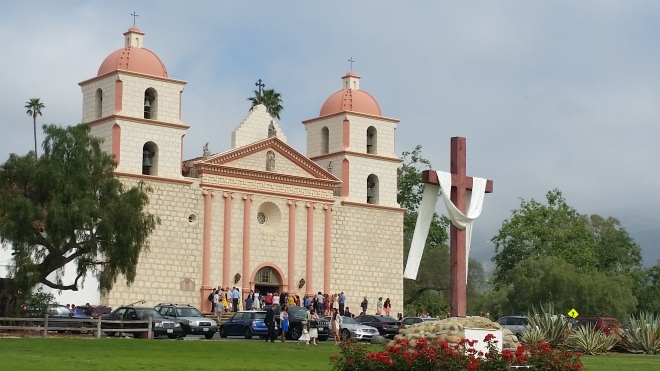 From here we drove further north on route (pronounced ‘rowt’) 101 – which alternates between being the 101 and highway 1 – to a lovely small place named Morro Bay. Prior to arriving there we stopped for lunch at a place called Madonna Inn, and if you’re ever in the area, do call in and see it for yourself! It’s…, well it’s…, hard to know how to describe, really. Friends told us about it, and it was worth the hour of our time. The lunch wasn’t bad either! Anyhow, back to Morro Bay. Only a small place, but it has a huge volcanic rock that separates the harbour and the Bay. The day we arrived it was mega windy (we struggled to open the car door) and we sat, after our ‘walk’ along the beach turned into an enforced sprint, watching someone kitesurfing on the raging seas; it was phenomenal to watch and whoever it was, was lifted 10-15 metres in the air, several times, and carried along by the wind. Incredible!
From here we drove further north on route (pronounced ‘rowt’) 101 – which alternates between being the 101 and highway 1 – to a lovely small place named Morro Bay. Prior to arriving there we stopped for lunch at a place called Madonna Inn, and if you’re ever in the area, do call in and see it for yourself! It’s…, well it’s…, hard to know how to describe, really. Friends told us about it, and it was worth the hour of our time. The lunch wasn’t bad either! Anyhow, back to Morro Bay. Only a small place, but it has a huge volcanic rock that separates the harbour and the Bay. The day we arrived it was mega windy (we struggled to open the car door) and we sat, after our ‘walk’ along the beach turned into an enforced sprint, watching someone kitesurfing on the raging seas; it was phenomenal to watch and whoever it was, was lifted 10-15 metres in the air, several times, and carried along by the wind. Incredible!
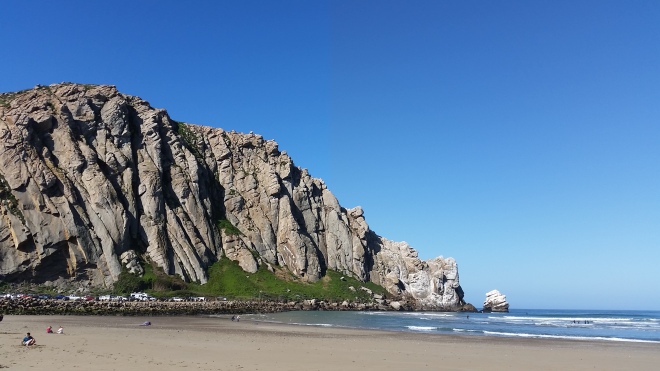 The following day was much calmer and we strolled along the embarcadero, stopping to watch the playful otters in the marina. We chatted with an elderly American couple; the gentleman was super impressed with our trip and told us we were ‘outta his league!’ He’s never left California – why would he, he asked, he had everything he wanted right there. Fair comment.
The following day was much calmer and we strolled along the embarcadero, stopping to watch the playful otters in the marina. We chatted with an elderly American couple; the gentleman was super impressed with our trip and told us we were ‘outta his league!’ He’s never left California – why would he, he asked, he had everything he wanted right there. Fair comment.
The next leg of our journey was something else. Google maps was directing us up the freeway several miles east of the coast to Monterray. We ignored it. We had always planned to drive up the coast, but after chatting with a lady in the line up at the church who mentioned the Big Sur, which we subsequently looked up, we were even more determined to ignore Google maps!
It was a stunningly beautiful drive: dramatic cliffs, tucked-away bays, a twisting and turning highway that, here and there, shaved the cliff which dropped many feet to the ocean, rolling hills and all with a backdrop of an azure blue sky that went on for ever. Bliss!
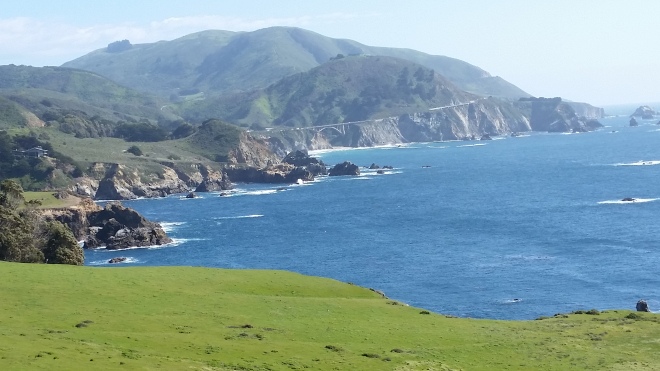 The driving was quite intense and good old Google’s prediction of 2.5 hours, grossly underestimated. It took pretty much all day and the concentration required was quite significant. The puncture we sustained was, thankfully, as we were nearing the end of our journey, and necessitated a detour to the Goodyear tyre garage for a replacement, before arriving at our motel for a well deserved beer, follwed by rest for my amazing chauffeur.
The driving was quite intense and good old Google’s prediction of 2.5 hours, grossly underestimated. It took pretty much all day and the concentration required was quite significant. The puncture we sustained was, thankfully, as we were nearing the end of our journey, and necessitated a detour to the Goodyear tyre garage for a replacement, before arriving at our motel for a well deserved beer, follwed by rest for my amazing chauffeur.
Because of the tyre situation, we hadn’t been able to stop at Carmel, so we re-traced our steps the following morning. I really wanted to go because many of Danielle Steele’s (you’ll have heard of her if you’re my age, I bet!) protagonists drove up to Carmel when it all got a bit too much in San Francisco, and they needed to get away to mull things over. It was another gorgeous small town, with, I would guess, plenty of people with plenty of money. The beach was at the end of this pretty little road which we walked down in 5 minutes from the town. It was beautiful, and, much to my husband’s dismay (as we found out afterwards), Doris Day lives there and appeared on her balcony to celebrate her 92nd birthday just 2 days after we’d visited! He’s a big fan.
Our next destination left us, once again, open-mouthed and repeating similar superlatives used at the Grand Canyon.
Yosemite National Park is 7 miles long, 1 mile wide with the tallest granite rock just a mere 7000 feet high. In contrast to the Grand Canyon, where we stood on the rim and looked down, here we were cricking our necks looking up to try and see the top! El Capitan, Half Dome, Sentinel and Cathedral rocks, to name just a few were breathtaking, not least because of their size. The tall pine trees which dwarfed us were like snippings of garden twine against them. Bridalveil, Horseshoe, Sentinal and Vernal falls were immense and we could hear the roar of the water from our tent at night. These incredible natural wonders are so humbling and really do make you realise the absolute power of nature and (wo)man’s insignificance in comparison. Who do we think we are, really?
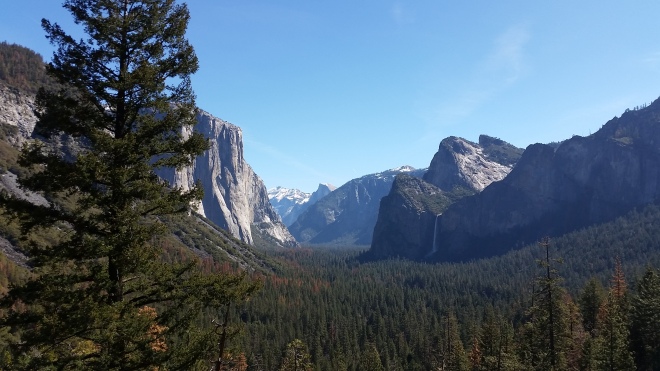 Again, blessed with wonderful weather for our 2 days here, we were able to see the place at its absolute best, as we completed a 5 plus miles hike to, and around, Mirror Lake during which we encountered the tallest pine trees, the stillest water, the prettiest glades and babbling creeks…you get the picture. It was all just beguiling. Our bear-proof tent was something else, and the campsite was very strict about not leaving rubbish, food or toiletries in your tent, or car; we saw photographic evidence of trashed cars where bears have tried to enter…
Again, blessed with wonderful weather for our 2 days here, we were able to see the place at its absolute best, as we completed a 5 plus miles hike to, and around, Mirror Lake during which we encountered the tallest pine trees, the stillest water, the prettiest glades and babbling creeks…you get the picture. It was all just beguiling. Our bear-proof tent was something else, and the campsite was very strict about not leaving rubbish, food or toiletries in your tent, or car; we saw photographic evidence of trashed cars where bears have tried to enter…
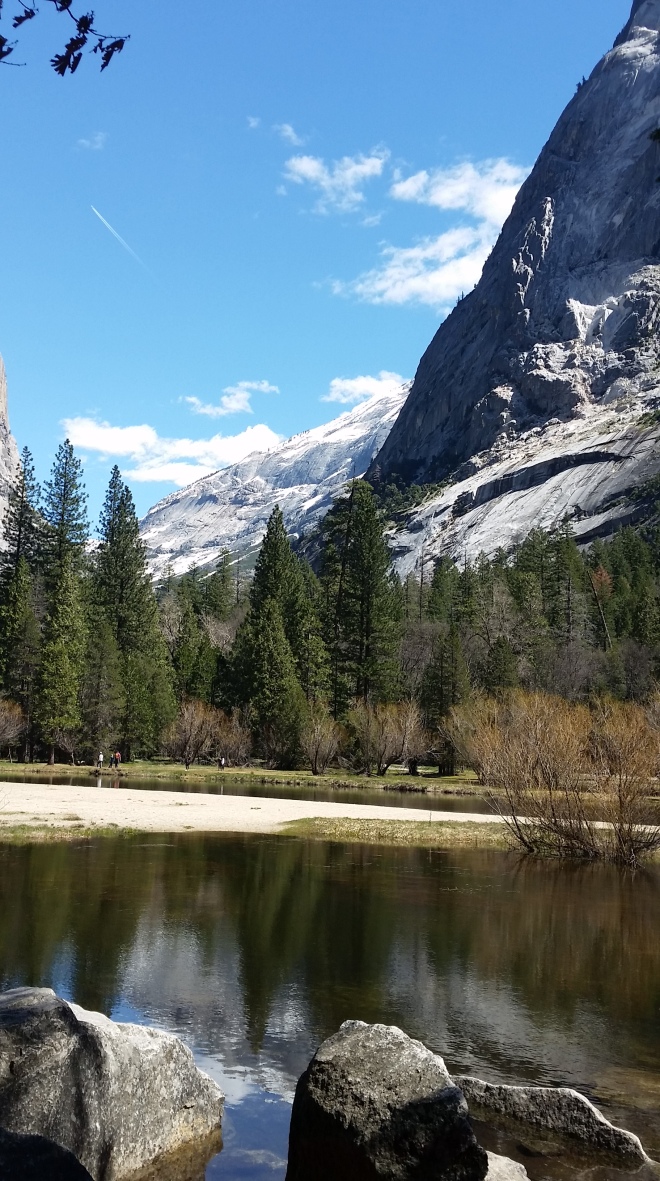 Leaving this beautiful haven of peace and tranquillity, we began our journey westwards towards San Francisco, where we were very excited to be going. But not before we had been to Sacramento and the Old Town there. During the gold rush period it had been the richest place in California, we were reliably informed by the old lady, dressed in character, at the visitor centre. The buildings are beautifully maintained in their original ‘cowboy’ days state, and we walked on boardwalks instead of pavements. We were on the lookout for someone to be eliminated from a bar through some swing doors onto the street on the end of someone’s boot!
Leaving this beautiful haven of peace and tranquillity, we began our journey westwards towards San Francisco, where we were very excited to be going. But not before we had been to Sacramento and the Old Town there. During the gold rush period it had been the richest place in California, we were reliably informed by the old lady, dressed in character, at the visitor centre. The buildings are beautifully maintained in their original ‘cowboy’ days state, and we walked on boardwalks instead of pavements. We were on the lookout for someone to be eliminated from a bar through some swing doors onto the street on the end of someone’s boot!
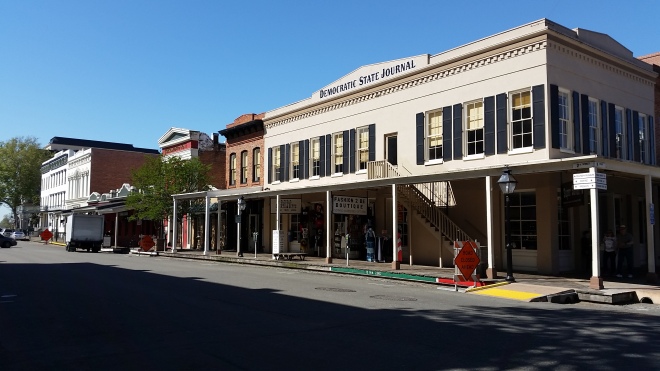 Then we were on our way to San Francisco! There was a great sense of satisfaction and achievement that we had, after around 2600 miles and 26 days on the road, arrived at our final destination in America, never mind the fact that it was also San Francisco! Credit to Google maps offline, free hotel wifi and to the navigator – me – who ensured only the very minimal number of errors (which only occurred when the driver failed to listen!)
Then we were on our way to San Francisco! There was a great sense of satisfaction and achievement that we had, after around 2600 miles and 26 days on the road, arrived at our final destination in America, never mind the fact that it was also San Francisco! Credit to Google maps offline, free hotel wifi and to the navigator – me – who ensured only the very minimal number of errors (which only occurred when the driver failed to listen!)
 We loved San Francisco. The people and the place are strong, resilient and stoical in order to have literally picked themselves up, dusted themselves off and started all over again three times after earthquakes have destroyed much of their beautiful city. The last significant one was in 1989.
We loved San Francisco. The people and the place are strong, resilient and stoical in order to have literally picked themselves up, dusted themselves off and started all over again three times after earthquakes have destroyed much of their beautiful city. The last significant one was in 1989.
The city, if you don’t know, is built on over 50 hills, and is 7 miles long and the same distance in width. It has a lovely circular bay in which sits The Rock, aka Alcatraz, once the formidable home to Al Capone and other notorious law breakers. Only 3 people ever escaped and no one knows if they drowned in their attempt to get to the mainland or if they were successful, and once again enjoyed their liberty.
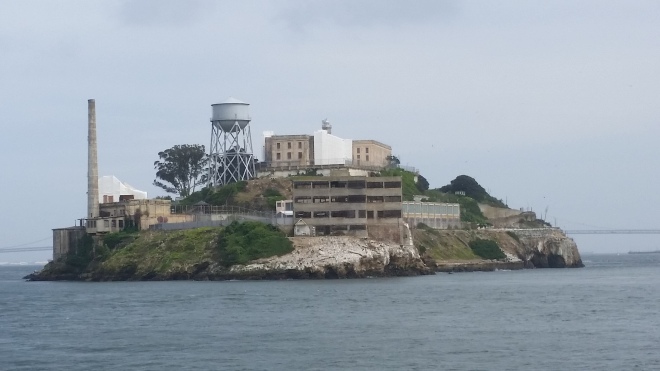 Cable cars traverse the incredibly steep hills which run through the city. Unfortunately these are not indicated on the map so thinking ‘we can walk from a to b’ is not that simple when you round a corner and a mountain of tarmac greets you! The cable cars are amazing vehicles, originally invented by someone who couldn’t bear to see how the horses, that used to pull carriages of people up the hills, got injured. The cars have no engines and are pulled by a steel cable embedded in the street that is continually moving at a steady 9 mph. The only way to stop the cable car is by forcing a wooden lever down hard onto the ground.
Cable cars traverse the incredibly steep hills which run through the city. Unfortunately these are not indicated on the map so thinking ‘we can walk from a to b’ is not that simple when you round a corner and a mountain of tarmac greets you! The cable cars are amazing vehicles, originally invented by someone who couldn’t bear to see how the horses, that used to pull carriages of people up the hills, got injured. The cars have no engines and are pulled by a steel cable embedded in the street that is continually moving at a steady 9 mph. The only way to stop the cable car is by forcing a wooden lever down hard onto the ground.
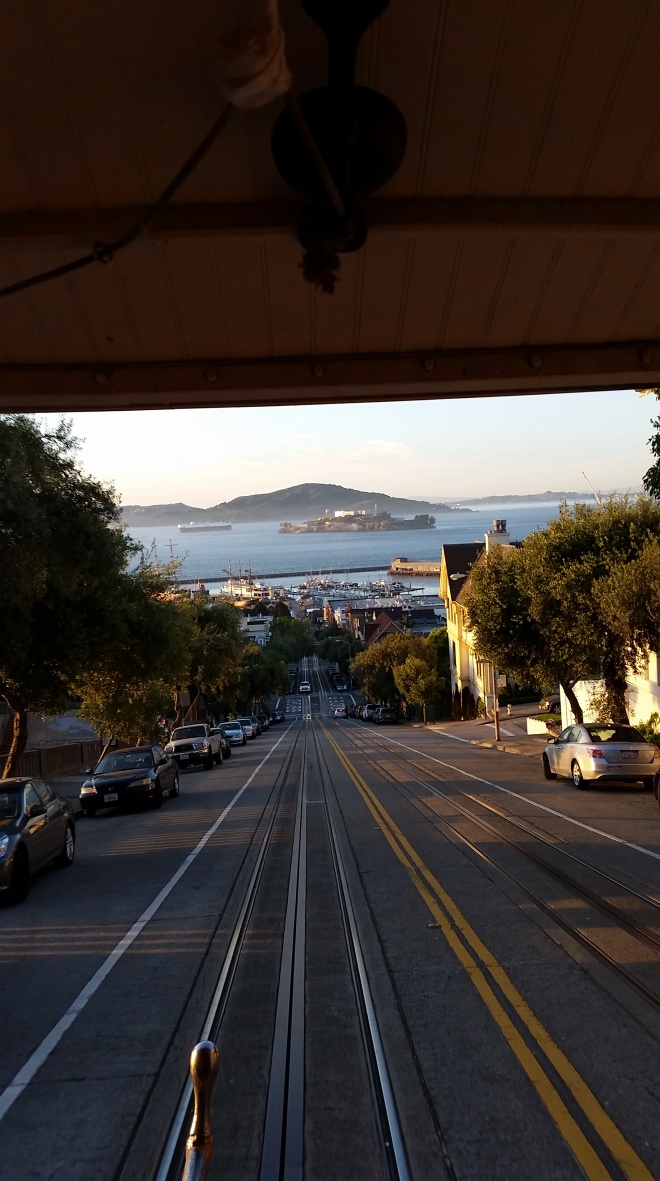 For you pub-quiz-goers, there have only ever been 3 women drivers of cable cars, because of the strength needed. The first of these women was the late and great novelist, Maya Angelou.
For you pub-quiz-goers, there have only ever been 3 women drivers of cable cars, because of the strength needed. The first of these women was the late and great novelist, Maya Angelou.
Other trivia about San Francisco, that may or may not be useful to you over your life time, are as follows:
* there are more cats and dogs in the city than children registered in schools
* providing you wear once piece of clothing, i.e. a hat, it is perfectly legal to walk naked around the city
* Robin Williams rode his bike around the city, autographed it and donated it to charity for auctioning
* The Mrs Doubtfire house is in the city
* Golden Gate bridge is so named because it spans the Golden Gate Straits, and not because of its colour
* There are only 2 cemeteries in the city – one for veterans and one for pets
As the United States of America leg of our trip drew to a close, we reflected on our thoughts and experiences here. We came with no expectations, and therefore have not been disappointed. We have not been anywhere that we have not enjoyed. The natural world has featured very large in our experiences and the vastness of the Arizona desert, the sheer size of Utah’s Monument Valley, Grand Canyon’s incredible beauty and the unparalleled (in our experience, at least) Yosemite National Park will be hard to beat. These places have completely bowled us over and our senses have been enhanced 10 fold in the 2 months since we left home. What does Canada’s west coast hold for us, I wonder…

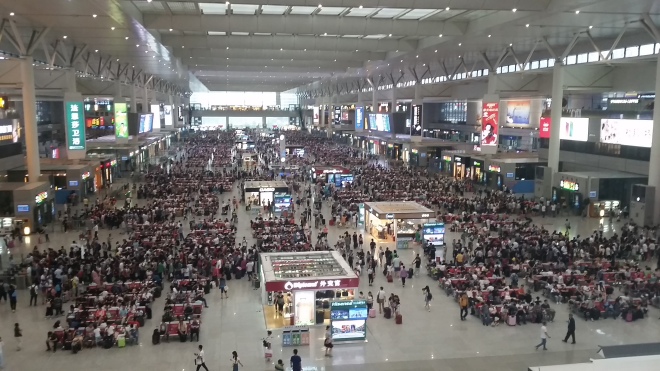
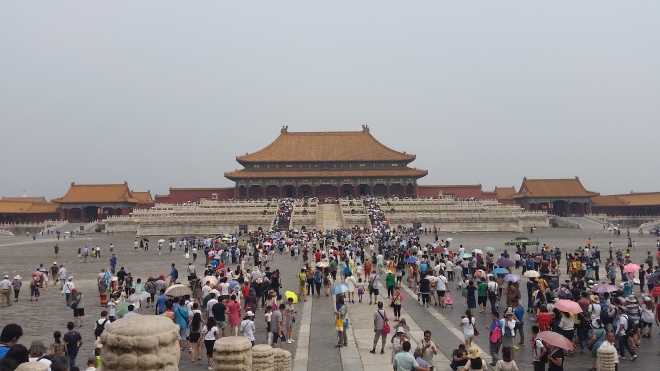 Our walk on The Great Wall took place on a part of the wall in Jinshanling about a 3 hour drive from Beijing. It was worth the drive as we pretty much had The Wall to ourselves. We were prepared for a 3 hour walk: hats, suncream, plenty of water and comfortable shoes. However we were not prepared for the incredible humidity and heat, despite the fact it was cloudy and early in the day. A group of Mongolian ladies wait every day to walk alongside hikers and offer support, if necessary. A slim, shy lady in kitten heels and a neutral shade of foot socks attached herself to us, and I, for one, am very glad that she did. After a gradual and steady incline we began to climb steps and shortly I began to feel the combined effects of the heat and the exercise. After a couple of stops, my new friend began to offer me a helping hand up the steps, which seemed to get taller each time I raised my leg. She whipped a large hand fan out of her bag and fanned me as I stopped every now and then to get my breath back. We were on The Wall now and it was a spectacular sight from the look out towers that we came across every now and then. Despite the cloud and haze we could make out the heavily tree-covered mountainous terrain that surrounded us 360°. The Great Wall stretched out before us and behind us as far as the eye could see. An incredible and ancient man-made feature on the face of planet earth – and we were standing on it. On the one side of the wall were battlements so that missiles could be aimed at the approaching enemies. Part of the wall has been replaced and repaired over the years but we also saw, and walked on, part of the original wall. Unfortunately by this time I was feeling lightheaded, dizzy and nauseous so chose to take a path from the wall down to our starting point and wait for the rest of the group. My supportive lady came with me and was so kind. A mixture of emotions overwhelmed me: relief that I didn’t have to continue walking for another couple of hours, disappointment in myself that I couldn’t complete the walk with the group and an overwhelming realisation that I was not as young and fit as I once was. However, when I was feeling calmer, I rationalised that I had made it up onto the wall and had walked along it for some of the way which had been the aim when we set out that morning. Therefore I had achieved that and had not failed myself.
Our walk on The Great Wall took place on a part of the wall in Jinshanling about a 3 hour drive from Beijing. It was worth the drive as we pretty much had The Wall to ourselves. We were prepared for a 3 hour walk: hats, suncream, plenty of water and comfortable shoes. However we were not prepared for the incredible humidity and heat, despite the fact it was cloudy and early in the day. A group of Mongolian ladies wait every day to walk alongside hikers and offer support, if necessary. A slim, shy lady in kitten heels and a neutral shade of foot socks attached herself to us, and I, for one, am very glad that she did. After a gradual and steady incline we began to climb steps and shortly I began to feel the combined effects of the heat and the exercise. After a couple of stops, my new friend began to offer me a helping hand up the steps, which seemed to get taller each time I raised my leg. She whipped a large hand fan out of her bag and fanned me as I stopped every now and then to get my breath back. We were on The Wall now and it was a spectacular sight from the look out towers that we came across every now and then. Despite the cloud and haze we could make out the heavily tree-covered mountainous terrain that surrounded us 360°. The Great Wall stretched out before us and behind us as far as the eye could see. An incredible and ancient man-made feature on the face of planet earth – and we were standing on it. On the one side of the wall were battlements so that missiles could be aimed at the approaching enemies. Part of the wall has been replaced and repaired over the years but we also saw, and walked on, part of the original wall. Unfortunately by this time I was feeling lightheaded, dizzy and nauseous so chose to take a path from the wall down to our starting point and wait for the rest of the group. My supportive lady came with me and was so kind. A mixture of emotions overwhelmed me: relief that I didn’t have to continue walking for another couple of hours, disappointment in myself that I couldn’t complete the walk with the group and an overwhelming realisation that I was not as young and fit as I once was. However, when I was feeling calmer, I rationalised that I had made it up onto the wall and had walked along it for some of the way which had been the aim when we set out that morning. Therefore I had achieved that and had not failed myself.
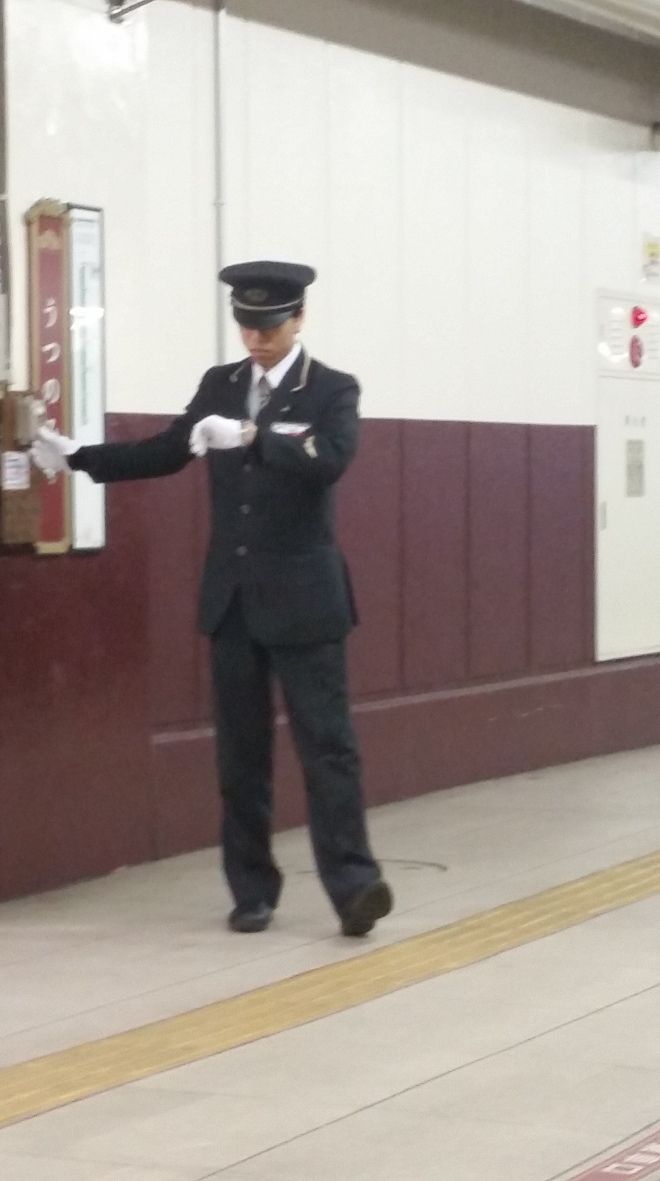



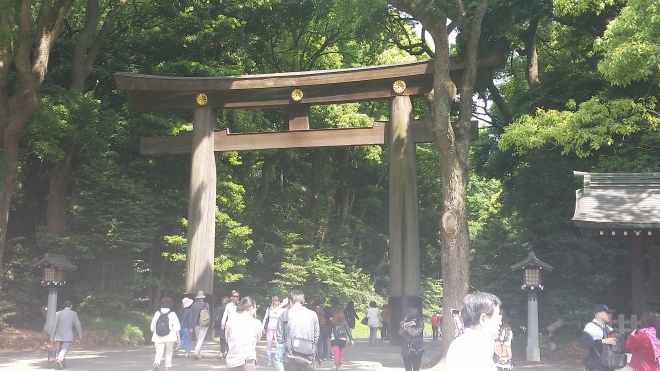
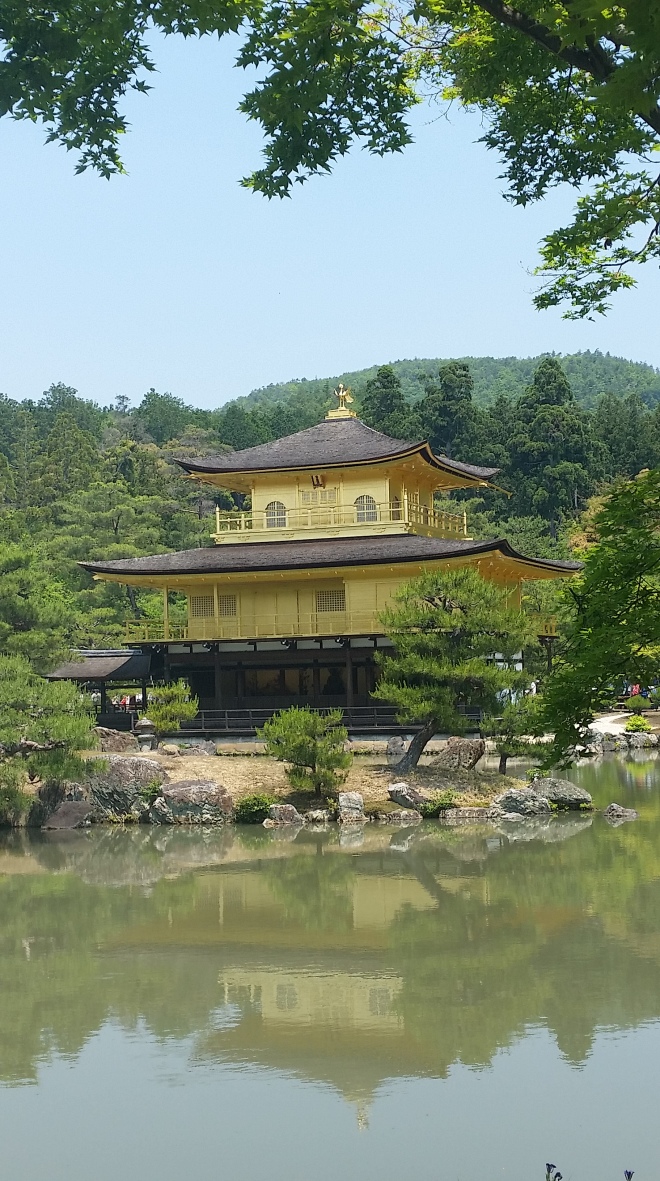




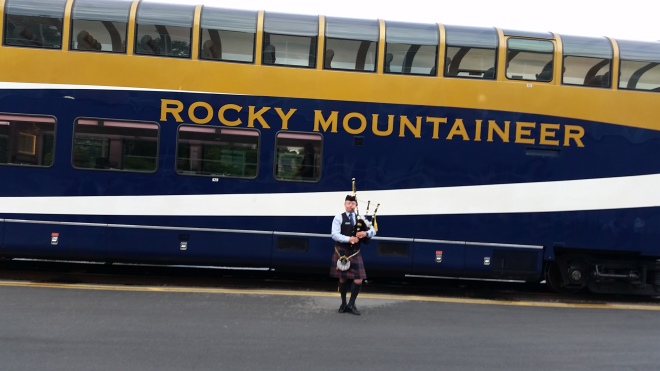 As the train began its two day trail, deep into the heart of Canada’s rocky mountains and Jasper, we left the station to a line up of ground staff, resplendent in their uniforms, genuine sunny smiles on their faces waving us off with heartfelt wishes for a fantastic journey. It was a really lovely send – off! We travelled slowly to begin with through the railyards and before too long the hard concrete and glass buildings of the city gave way to nature’s restorative green trees and forests alongside blue waters of the Fraser river, which we followed for a good part of our journey to Kamloops on day one. Very surprisingly, this landscape changed and became desert; but for the river, we could have been in Arizona, remarked a fellow passenger, and having been there now, we could agree.
As the train began its two day trail, deep into the heart of Canada’s rocky mountains and Jasper, we left the station to a line up of ground staff, resplendent in their uniforms, genuine sunny smiles on their faces waving us off with heartfelt wishes for a fantastic journey. It was a really lovely send – off! We travelled slowly to begin with through the railyards and before too long the hard concrete and glass buildings of the city gave way to nature’s restorative green trees and forests alongside blue waters of the Fraser river, which we followed for a good part of our journey to Kamloops on day one. Very surprisingly, this landscape changed and became desert; but for the river, we could have been in Arizona, remarked a fellow passenger, and having been there now, we could agree.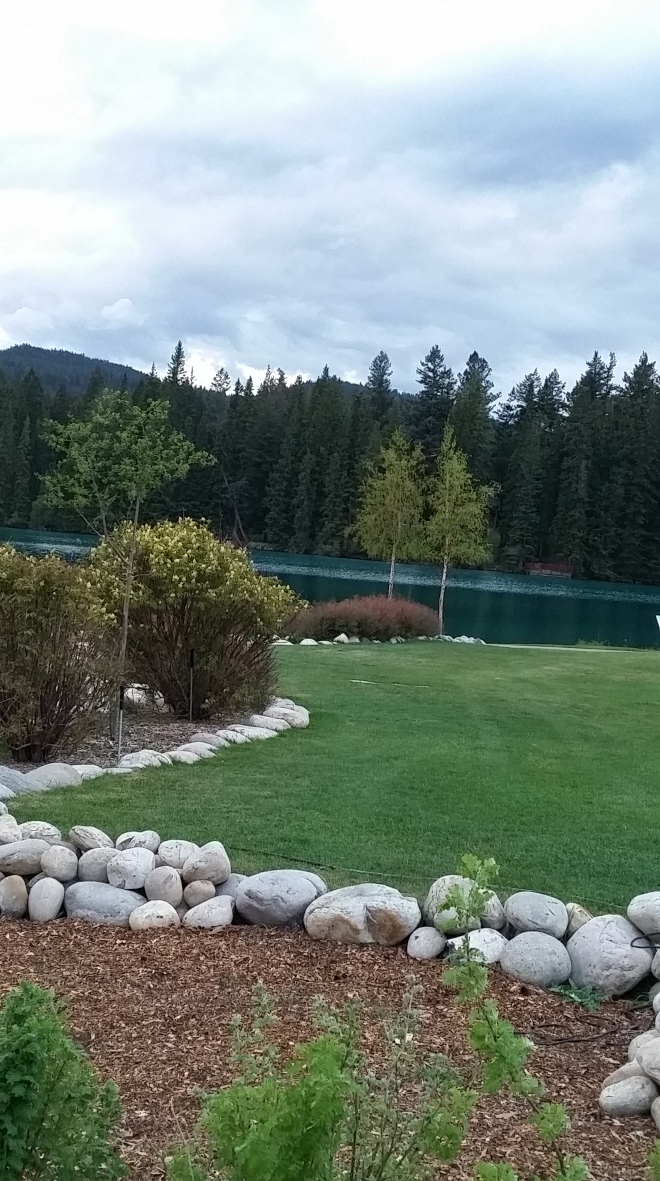 The following day, in increasing sunshine, we enjoyed all that nature offered in and around Jasper: Maligne Canyon, Patricia and Pyramid Lakes and on our wildlife spotting evening tour, we were very lucky to see a bear, thanks to the eagle-eyed Irish lady on our bus. We also saw some elks and a bald headed eagle in her nest at Medicine Lake. The driver/ guide was very knowledgeable and passionate about the wildlife and the local area and kept us all well informed, and entertained, about what we were seeing.
The following day, in increasing sunshine, we enjoyed all that nature offered in and around Jasper: Maligne Canyon, Patricia and Pyramid Lakes and on our wildlife spotting evening tour, we were very lucky to see a bear, thanks to the eagle-eyed Irish lady on our bus. We also saw some elks and a bald headed eagle in her nest at Medicine Lake. The driver/ guide was very knowledgeable and passionate about the wildlife and the local area and kept us all well informed, and entertained, about what we were seeing.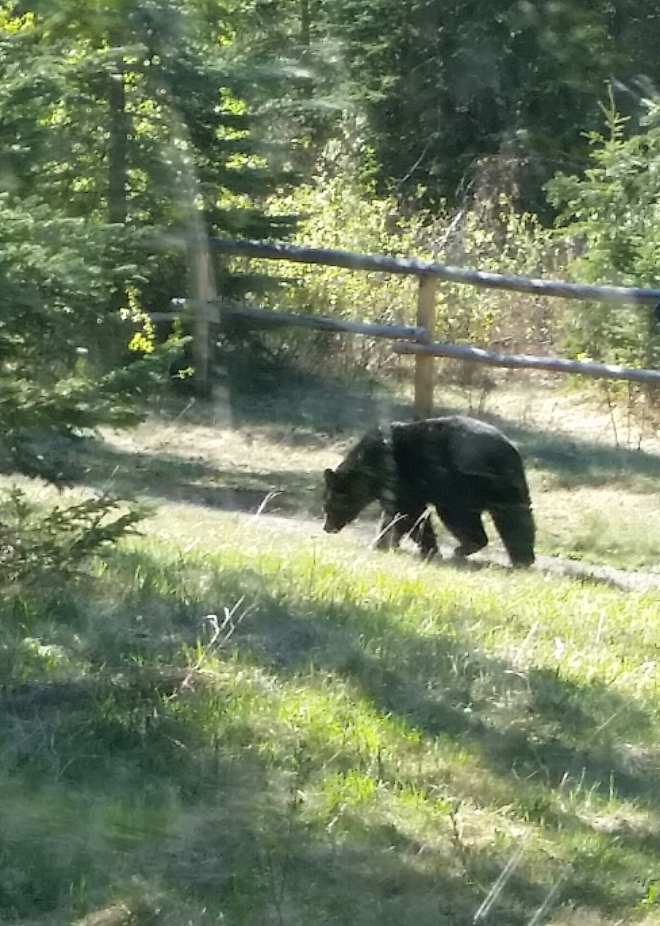 We sat watching and taking photographs, but that wasn’t enough for some people. They wanted to get off the bus, and as the driver had reluctantly opened the doors (so they could get better pictures) they began slipping off one by one and getting ridiculously close so they could take their selfies – without any apparant thought that the bear could have, at any moment, moved much quicker than them… it was a wild animal. The bear did get up and, thankfully, walked away from us, but it was a good job he was so pre-occupied with his food. This time of year, after hibernation, bears are very hungry and have little energy. Therefore food is vital for them. As they begin to get stronger and less ravenous they move further up in to the forest and are less likely to be visible. The bus driver was required to report the bear sighting to the parks ranger so that they could come and put up barriers to make sure the bear was protected and people were not in danger. He was also concerned that he would be reported for letting people off the bus. His unfortunate mistake was opening the doors: some people chose to ignore his requests to remain on the bus. I’m just glad no – one was attacked, but they so easily could have been. About 10 minutes after we left the bear, we saw a lone wolf walking in the opposite direction on the other side of the river. This is a rare occurrence to see one on its own, so we were incredibly lucky, once again.
We sat watching and taking photographs, but that wasn’t enough for some people. They wanted to get off the bus, and as the driver had reluctantly opened the doors (so they could get better pictures) they began slipping off one by one and getting ridiculously close so they could take their selfies – without any apparant thought that the bear could have, at any moment, moved much quicker than them… it was a wild animal. The bear did get up and, thankfully, walked away from us, but it was a good job he was so pre-occupied with his food. This time of year, after hibernation, bears are very hungry and have little energy. Therefore food is vital for them. As they begin to get stronger and less ravenous they move further up in to the forest and are less likely to be visible. The bus driver was required to report the bear sighting to the parks ranger so that they could come and put up barriers to make sure the bear was protected and people were not in danger. He was also concerned that he would be reported for letting people off the bus. His unfortunate mistake was opening the doors: some people chose to ignore his requests to remain on the bus. I’m just glad no – one was attacked, but they so easily could have been. About 10 minutes after we left the bear, we saw a lone wolf walking in the opposite direction on the other side of the river. This is a rare occurrence to see one on its own, so we were incredibly lucky, once again.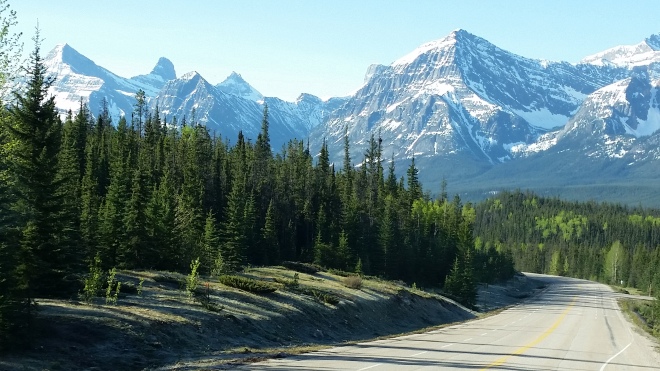 The Athabasca Glacier was dazzling and we were taken on a huge ice explorer vehicle, driven by a remarkably young looking lady who handled it extremely well and was also very knowledgeable about glaciers, their formation and the way in which they are changing. This one is 265 metres deep, 1 kilometre wide and 6 kilometres long. About 150 years ago it was 8 kilometres long and it has been retreating since the end of last ice age. It was a beautifully warm day and we stood on the glacier ice, which has been there for 10 to 15 thousand years, marvelling at our spectacular surroundings and the power of the earth which caused such magnificent structures. The Rocky mountains were caused by 250 miles of ocean floor erupting into 75 miles of mountain range. Just imagine witnessing such an event! Once again, this sight and knowledge brings it home that humankind has no such power, and thinking we can meddle with nature is futile.
The Athabasca Glacier was dazzling and we were taken on a huge ice explorer vehicle, driven by a remarkably young looking lady who handled it extremely well and was also very knowledgeable about glaciers, their formation and the way in which they are changing. This one is 265 metres deep, 1 kilometre wide and 6 kilometres long. About 150 years ago it was 8 kilometres long and it has been retreating since the end of last ice age. It was a beautifully warm day and we stood on the glacier ice, which has been there for 10 to 15 thousand years, marvelling at our spectacular surroundings and the power of the earth which caused such magnificent structures. The Rocky mountains were caused by 250 miles of ocean floor erupting into 75 miles of mountain range. Just imagine witnessing such an event! Once again, this sight and knowledge brings it home that humankind has no such power, and thinking we can meddle with nature is futile. As we left the glacier behind we continued along the Icefield Parkway, with a running commentary from Robin, our driver for the day. What he didn’t know about everything we were seeing, together with the history of the place wasn’t worth knowing. We stopped at several lakes with, as you’d expect by now, beautiful vistas all made even more stunning with the glorious weather. Bow Lake was especially beautiful, and was named, I guess, because of the bow (arrow kind) like shape made with the reflection from the way the snow was left on the mountain.
As we left the glacier behind we continued along the Icefield Parkway, with a running commentary from Robin, our driver for the day. What he didn’t know about everything we were seeing, together with the history of the place wasn’t worth knowing. We stopped at several lakes with, as you’d expect by now, beautiful vistas all made even more stunning with the glorious weather. Bow Lake was especially beautiful, and was named, I guess, because of the bow (arrow kind) like shape made with the reflection from the way the snow was left on the mountain. We finally pulled into our lovely hotel at Lake Louise at the end of a fabulous day. This day was up there with Grand Canyon Day and left us both feeling quite emotionally drained. Nothing can compare with the beauty and majesty of these places and I can’t do justice to them with words or pictures. I now know what Awe and Wonder is, and nothing material would ever touch my soul in the same way. If there are places that you know you want to see, then go there. You have to feel the place; absorb it through your senses and take it home with you in your heart and in your memory. Seeing it on the Discovery Channel just doesn’t cut it.
We finally pulled into our lovely hotel at Lake Louise at the end of a fabulous day. This day was up there with Grand Canyon Day and left us both feeling quite emotionally drained. Nothing can compare with the beauty and majesty of these places and I can’t do justice to them with words or pictures. I now know what Awe and Wonder is, and nothing material would ever touch my soul in the same way. If there are places that you know you want to see, then go there. You have to feel the place; absorb it through your senses and take it home with you in your heart and in your memory. Seeing it on the Discovery Channel just doesn’t cut it.













 From here we drove further north on route (pronounced ‘rowt’) 101 – which alternates between being the 101 and highway 1 – to a lovely small place named Morro Bay. Prior to arriving there we stopped for lunch at a place called Madonna Inn, and if you’re ever in the area, do call in and see it for yourself! It’s…, well it’s…, hard to know how to describe, really. Friends told us about it, and it was worth the hour of our time. The lunch wasn’t bad either! Anyhow, back to Morro Bay. Only a small place, but it has a huge volcanic rock that separates the harbour and the Bay. The day we arrived it was mega windy (we struggled to open the car door) and we sat, after our ‘walk’ along the beach turned into an enforced sprint, watching someone kitesurfing on the raging seas; it was phenomenal to watch and whoever it was, was lifted 10-15 metres in the air, several times, and carried along by the wind. Incredible!
From here we drove further north on route (pronounced ‘rowt’) 101 – which alternates between being the 101 and highway 1 – to a lovely small place named Morro Bay. Prior to arriving there we stopped for lunch at a place called Madonna Inn, and if you’re ever in the area, do call in and see it for yourself! It’s…, well it’s…, hard to know how to describe, really. Friends told us about it, and it was worth the hour of our time. The lunch wasn’t bad either! Anyhow, back to Morro Bay. Only a small place, but it has a huge volcanic rock that separates the harbour and the Bay. The day we arrived it was mega windy (we struggled to open the car door) and we sat, after our ‘walk’ along the beach turned into an enforced sprint, watching someone kitesurfing on the raging seas; it was phenomenal to watch and whoever it was, was lifted 10-15 metres in the air, several times, and carried along by the wind. Incredible! The following day was much calmer and we strolled along the embarcadero, stopping to watch the playful otters in the marina. We chatted with an elderly American couple; the gentleman was super impressed with our trip and told us we were ‘outta his league!’ He’s never left California – why would he, he asked, he had everything he wanted right there. Fair comment.
The following day was much calmer and we strolled along the embarcadero, stopping to watch the playful otters in the marina. We chatted with an elderly American couple; the gentleman was super impressed with our trip and told us we were ‘outta his league!’ He’s never left California – why would he, he asked, he had everything he wanted right there. Fair comment. The driving was quite intense and good old Google’s prediction of 2.5 hours, grossly underestimated. It took pretty much all day and the concentration required was quite significant. The puncture we sustained was, thankfully, as we were nearing the end of our journey, and necessitated a detour to the Goodyear tyre garage for a replacement, before arriving at our motel for a well deserved beer, follwed by rest for my amazing chauffeur.
The driving was quite intense and good old Google’s prediction of 2.5 hours, grossly underestimated. It took pretty much all day and the concentration required was quite significant. The puncture we sustained was, thankfully, as we were nearing the end of our journey, and necessitated a detour to the Goodyear tyre garage for a replacement, before arriving at our motel for a well deserved beer, follwed by rest for my amazing chauffeur. Again, blessed with wonderful weather for our 2 days here, we were able to see the place at its absolute best, as we completed a 5 plus miles hike to, and around, Mirror Lake during which we encountered the tallest pine trees, the stillest water, the prettiest glades and babbling creeks…you get the picture. It was all just beguiling. Our bear-proof tent was something else, and the campsite was very strict about not leaving rubbish, food or toiletries in your tent, or car; we saw photographic evidence of trashed cars where bears have tried to enter…
Again, blessed with wonderful weather for our 2 days here, we were able to see the place at its absolute best, as we completed a 5 plus miles hike to, and around, Mirror Lake during which we encountered the tallest pine trees, the stillest water, the prettiest glades and babbling creeks…you get the picture. It was all just beguiling. Our bear-proof tent was something else, and the campsite was very strict about not leaving rubbish, food or toiletries in your tent, or car; we saw photographic evidence of trashed cars where bears have tried to enter… Leaving this beautiful haven of peace and tranquillity, we began our journey westwards towards San Francisco, where we were very excited to be going. But not before we had been to Sacramento and the Old Town there. During the gold rush period it had been the richest place in California, we were reliably informed by the old lady, dressed in character, at the visitor centre. The buildings are beautifully maintained in their original ‘cowboy’ days state, and we walked on boardwalks instead of pavements. We were on the lookout for someone to be eliminated from a bar through some swing doors onto the street on the end of someone’s boot!
Leaving this beautiful haven of peace and tranquillity, we began our journey westwards towards San Francisco, where we were very excited to be going. But not before we had been to Sacramento and the Old Town there. During the gold rush period it had been the richest place in California, we were reliably informed by the old lady, dressed in character, at the visitor centre. The buildings are beautifully maintained in their original ‘cowboy’ days state, and we walked on boardwalks instead of pavements. We were on the lookout for someone to be eliminated from a bar through some swing doors onto the street on the end of someone’s boot! Then we were on our way to San Francisco!
Then we were on our way to San Francisco!  We loved San Francisco. The people and the place are strong, resilient and stoical in order to have literally picked themselves up, dusted themselves off and started all over again three times after earthquakes have destroyed much of their beautiful city. The last significant one was in 1989.
We loved San Francisco. The people and the place are strong, resilient and stoical in order to have literally picked themselves up, dusted themselves off and started all over again three times after earthquakes have destroyed much of their beautiful city. The last significant one was in 1989. Cable cars traverse the incredibly steep hills which run through the city. Unfortunately these are not indicated on the map so thinking ‘we can walk from a to b’ is not that simple when you round a corner and a mountain of tarmac greets you! The cable cars are amazing vehicles, originally invented by someone who couldn’t bear to see how the horses, that used to pull carriages of people up the hills, got injured. The cars have no engines and are pulled by a steel cable embedded in the street that is continually moving at a steady 9 mph. The only way to stop the cable car is by forcing a wooden lever down hard onto the ground.
Cable cars traverse the incredibly steep hills which run through the city. Unfortunately these are not indicated on the map so thinking ‘we can walk from a to b’ is not that simple when you round a corner and a mountain of tarmac greets you! The cable cars are amazing vehicles, originally invented by someone who couldn’t bear to see how the horses, that used to pull carriages of people up the hills, got injured. The cars have no engines and are pulled by a steel cable embedded in the street that is continually moving at a steady 9 mph. The only way to stop the cable car is by forcing a wooden lever down hard onto the ground. For you pub-quiz-goers, there have only ever been 3 women drivers of cable cars, because of the strength needed. The first of these women was the late and great novelist, Maya Angelou.
For you pub-quiz-goers, there have only ever been 3 women drivers of cable cars, because of the strength needed. The first of these women was the late and great novelist, Maya Angelou.